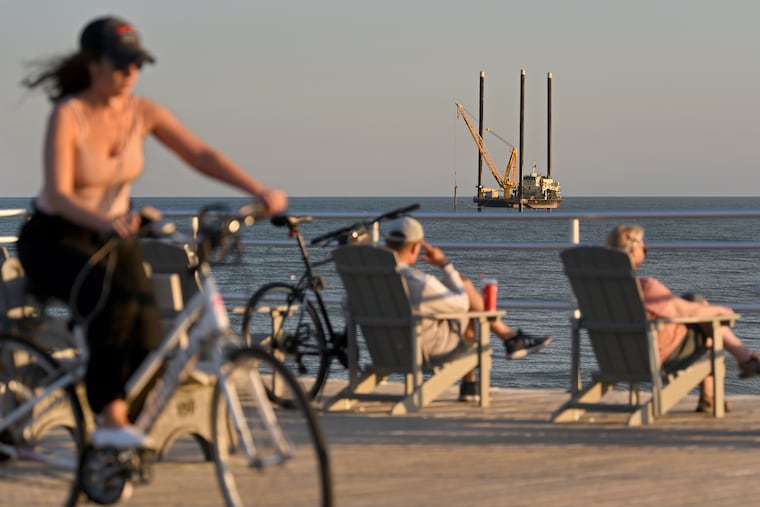Mystery barge offshore in Ventnor is trying to fix a big problem
The odd barge has prompted punchlines, but the explanation involves a buried steel pipe left over from a U.S. Army Corps beach replenishment that is now breaking apart in pieces.

VENTNOR, N.J. — What is that weird-looking barge off the coast of Ventnor?
It’s made for a lot of Facebook punchlines, not to mention the inevitable Facebook know-it-all clap-backs, but the real answer is actually more complicated, and not that funny: it’s part of a rather big (10,000 feet long to be exact) problem stemming from a recent $30 million U.S. Army Corps of Engineer beach replenishment.
So. Where to begin.
“No dumb questions,” assures Stephen Rochette, public affairs officer for the Army Corps Philadelphia district. “It’s an unusual thing!”
Rochette says back in December, 10,000 feet of 30-inch-diameter steel pipe, which had been used to pump sand from the ocean floor onto the Ventnor beach, was left out in the ocean by the Great Lakes Dredge & Dock, which did not return a phone call this week asking for more information.
Typically, a dredging company will come back in a month or two, when seas are calmer, Rochette said, to remove the heavy pipeline.
In this case, Great Lakes did not return until May. By then the pipe was completely submerged from storms.
“They removed other equipment in the December time frame,” Rochette said in a series of back-and-forth emails on the barge operation. The Army Corps’ replenishment efforts have prompted questions before on Absecon Island, particularly in Margate, where residents bitterly fought the project.
“The standard practice is they come back to get the submerged pipeline at a later date when there’s calm weather (usually a month or two),” he said. “I do not have information on why they waited.”
When they returned in May, Rochette said, “they had problems,” due to the pipe now being submerged under sand, with sand filling the inside of the pipe as well.
When they tried to remove the pipe in one piece, Rochette said, it began breaking apart at the joints.
Eagles practicing field goals?
And so the operation got more complicated, involving several tugboats, a crane atop the big spud barge with three pilings running down through it to anchor it, a hydraulic system pushing out the sand from the pipes, and the use of a “magnetometer” to survey the ocean floor to locate and keep track of the sections of pipe.
Rochette said “they technically have 2 crane derricks/barges there, and also a ‘jack-up ship’ (has the spuds) with a crane on it.” He said the project is not costing taxpayers any additional money.
All of which has led to repeated Facebook discussions, speculation about buried treasure, UFO’s, Eagles practicing field goals, or, more to the point, “It’s a new bike lane.”
“They’ve been removing it piece by piece,” said Rochette. “There’s about 1000 feet of pipe left. It’s offshore and it’s marked by buoys. Basically, they’ve pumped sand out of the pipe and have been pushing air into the pipe in an attempt to remove it.”
“They’d like to remove it in a whole section but it’s been coming apart at the joints of the pipe and they are bringing it out in sections,” he said.
He said the Army Corps was not concerned about any environmental impact from the operation and was confident all of the pipe would ultimately be located and removed, possibly as soon as this week. “The remaining pipe sections that come apart isn’t tiny pieces or anything like that,” he said. “It’s pretty massive 100-foot sections that just come apart at the pipe joints.”
‘Not visually pleasing’
On Thursday, directly across from the Troy Avenue beach, between a stand-up paddle boarder and a lifeguard boat bobbing in the waves, spurts of ocean water and sand could be seen rising up near the barge like a geyser. One of several tugboats carted off what appeared to be seven sections of pipe.
On the beach, Ed Winner and his granddaughter Clementine, 5, were doing their own magnetometer operation with a metal detector that ultimately turned up a colorful earring, in one piece.
Winner, coincidentally a former Navy scuba diver and submarine sailor, said he’d been staring at the barge for a week while on vacation from Central Pennsylvania. He said it reminded him of an operation to recover the Squalus submarine after it sunk off the coast of New Hampshire in the 1930s, which involved divers and fire hoses.
“We’ve been watching,” he said. “I see a burst of water bubbling up every once in awhile.”
As long as the rig wasn’t digging for oil, he said, he wasn’t overly concerned. “We still see dolphins,” he noted.
Irene Hung, a University of Pennsylvania nurse on vacation with her husband and toddler, noted, “I can’t imagine anyone’s, like, ‘I like this thing.’ ”
“It’s not visually pleasing,” added her husband, Len Podolsky, who said they’d been hit on occasion with “a nose full of exhaust,” from the barge, located at this point about 500 to 600 feet off the beach.
Rochette said the Army Corps did not anticipate any long-term effects from the pipe problem, despite its breaking into rather “massive” 100-foot sections. He said Great Lakes would use the magnetometer to make sure no pieces of metal pipe get left behind.
Ventnor Mayor Beth Holtzman said she hadn’t received any complaints about it, and noted that the operation, while visually arresting and puzzling, was much less disruptive than the actual dredging operation itself, which featured the steel pipe running along the beach, sections of the beach closed entirely, and the need to have guards stationed to keep children from playing on them.
“It’s not hurting anyone,” she said. “Just look the other way.”